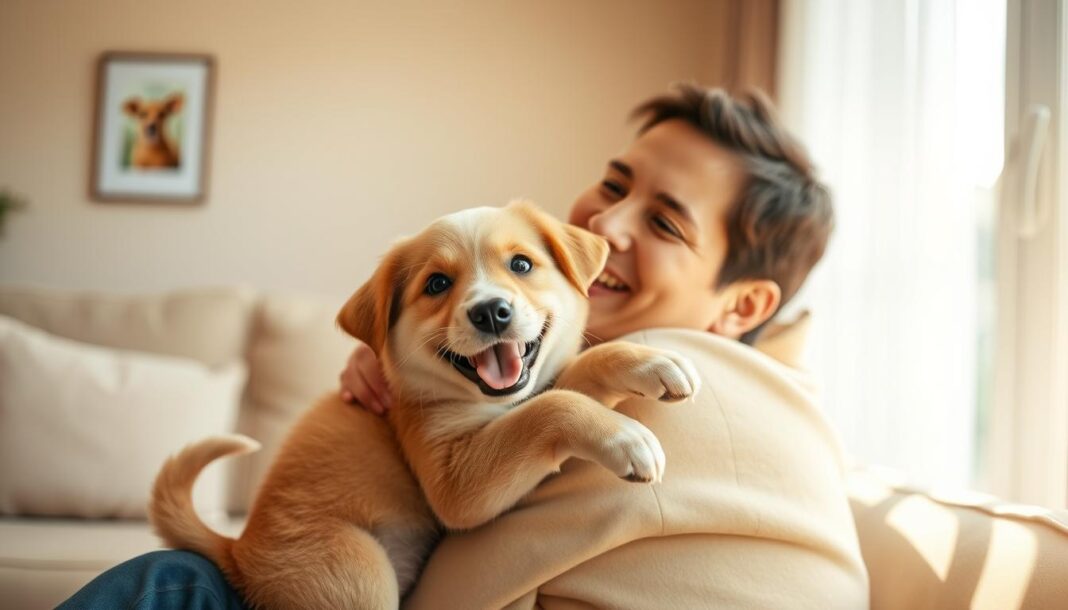Welcoming a pet into your family can change your life for the better. It brings joy and companionship. Studies show that pets can lower stress and help you meet new people, making your home happier.
Pets are more than animals to many; they’re family members who love you without condition. Understanding how pets improve your life can deepen your bond with them. This makes your home a more loving place.
Thinking about getting a new pet or wanting to bond more with your current one? Remember, pets play a big part in making your life better.
The Benefits of Pet Ownership
Pets can really make our lives better, offering emotional support and helping us relax. The special bond between a pet and their owner is based on trust, friendship, and love.
Emotional Support and Companionship
One big benefit of pet ownership is the emotional support and friendship they give. Pets are always ready to listen and comfort us, making us feel less lonely and isolated.
Stress Reduction and Mood Enhancement
Research shows that being around pets can lower blood pressure and stress, and even make us happier. Just petting a dog or cat can make us feel good by releasing happy hormones.
Combating Loneliness and Depression
Pets are key in fighting loneliness and depression by being our friends and giving us a reason to get up. For those living alone, a pet can be a constant friend, helping to fight off feelings of being alone.
| Benefits | Description | Impact |
|---|---|---|
| Emotional Support | Pets provide comfort and companionship | Reduces feelings of loneliness |
| Stress Reduction | Interacting with pets lowers blood pressure | Improves overall well-being |
| Mood Enhancement | Pets help release endorphins | Enhances mood and happiness |
Understanding the perks of having a pet can help you decide if it’s right for you. Whether you want a friend or a way to relax, a pet can be a great addition to your family.
Understanding Different Pet Personalities
Understanding your pet’s personality is key for a happy home. Each pet has its own traits that shape how they act and what they need.
Active vs. Laid-back Pets
Pet personalities range from very active to very laid-back. Active pets need lots of attention, exercise, and fun. On the other hand, laid-back pets are easy-going and don’t ask for much.
High-Energy Animals and Their Needs
Some pets, like certain dogs and cats, are very energetic. They need lots of exercise and fun activities. If they don’t get enough, they might act out.
But, calm pets are perfect for quiet homes. They like less excitement and can be happy with less activity. Knowing if your pet is energetic or calm helps you create the right space for them.
By understanding and meeting your pet’s needs, you can make your home happier for both you and your pet.
Dogs: Man’s Best Friend
Dogs are loyal and come in many breeds. They make great companions for many lifestyles. Their ability to bond with owners is unmatched.
Dogs have unique traits and needs. It’s important to pick the right breed for your home.
Popular Breeds for Different Lifestyles
There’s a dog breed for every lifestyle. Whether you’re active or like a calm life, there’s a perfect match.
Family-Friendly Dog Breeds
Labrador Retrievers and Golden Retrievers are great for families. They’re gentle and patient, perfect with kids.
Beagles and Boxers are also family-friendly. They’re energetic but loving.
Apartment-Appropriate Dogs
For apartment living, consider Bichon Frise and Shih Tzus. They’re small and don’t need much exercise.
Boston Terriers are quiet and well-behaved. They’re perfect for apartment living.
Choosing the right dog breed is key. Think about your lifestyle, activity level, and time commitment.
By picking the right breed, you’ll have a happy and healthy dog.
Cats: Independent Companions
Cats have a special way of winning our hearts with their independent nature. They offer companionship on their own terms. This makes them a favorite among many pet owners.
Indoor vs. Outdoor Cats
Deciding if your cat should stay indoors or go outside depends on several things. This includes your living situation and the cat’s personality. Indoor cats are safer from dangers like traffic and diseases. But, they need more attention to prevent boredom and obesity.
Outdoor cats get more freedom and stimulation. But, they face many risks. It’s important to think about these when deciding for your cat.
Safety Considerations for Both Options
For indoor cats, keeping them safe from falls and toxic substances is key. Outdoor cats face dangers like car accidents and diseases. These are big concerns.
Creating Enrichment for Indoor Cats
To keep indoor cats happy, you can create fun activities. This includes giving them different toys and climbing structures. Even simple things like opening a window for them to watch outside can help.
Understanding your cat’s needs and making good choices about their lifestyle is important. This way, you can help them live a happy and healthy life.
Small Mammals for Limited Spaces
You don’t need a big backyard to have a pet. Small mammals are perfect for those with little space. They can bring joy and companionship without needing a lot of room.
Rabbits, Guinea Pigs, and Hamsters
Rabbits, guinea pigs, and hamsters are great pets. They are easy to care for and love to be around people. They’re perfect for those living in apartments or with small spaces.
Lifespan and Commitment Levels
Think about how long your pet will live and how much care they need. Rabbits can live 8-12 years, guinea pigs 5-7 years, and hamsters 1.5-3 years.
| Pet | Lifespan | Commitment Level |
|---|---|---|
| Rabbits | 8-12 years | High |
| Guinea Pigs | 5-7 years | Medium-High |
| Hamsters | 1.5-3 years | Low-Medium |
Social vs. Solitary Small Pets
Some small mammals like to have friends, while others prefer to be alone. Guinea pigs like to live in pairs or groups. Hamsters, on the other hand, are best kept alone.
Knowing if your pet likes company or not is key. Whether you choose a social or solitary pet, make sure you meet their needs. This will make your pet happy and healthy.
Birds: Colorful and Intelligent Companions
Birds add vibrant colors and smartness to any home. They make great family pets. They keep you company and entertain you with their songs and fun actions.
Beginner-Friendly Bird Species
Some birds are perfect for beginners. They are easy to care for and love to be around people.
Budgies and Cockatiels
Budgies, or parakeets, are small and colorful. They can talk like humans and love to be social. Cockatiels are known for their calm nature and sweet singing. Both are great for beginners.
Canaries and Finches
Canaries sing beautifully, and finches are full of energy and love to be together. They are easy to care for and can make your home happier.
| Bird Species | Characteristics | Care Level |
|---|---|---|
| Budgies | Colorful, social, mimic human speech | Easy |
| Cockatiels | Gentle, affectionate, sing beautifully | Moderate |
| Canaries | Beautiful singing voices | Easy |
| Finches | Active, social, colorful | Easy |
Think about your lifestyle and how much time you can spend with a pet. Choose a beginner-friendly bird to ensure a happy and healthy bond.
Fish: Peaceful Aquatic Friends
Adding fish to your home can make it more peaceful. Fish are easy to care for and are calming to watch. They come in many species, each with its own needs.
Freshwater vs. Saltwater Aquariums
Choosing between a freshwater or saltwater aquarium is your first decision. Freshwater tanks are simpler and cheaper to start. Saltwater tanks need more skill and cost more upfront.
Difficulty Levels and Maintenance
Freshwater tanks are better for beginners because they’re easier to care for. Saltwater tanks require more precise water conditions and constant checks.
Cost Comparisons
The cost of an aquarium varies between freshwater and saltwater. Here’s a look at the differences:
| Aspect | Freshwater Aquariums | Saltwater Aquariums |
|---|---|---|
| Initial Setup Cost | Lower ($100-$500) | Higher ($500-$2,000) |
| Maintenance Cost | Lower ($50-$100/month) | Higher ($100-$300/month) |
| Equipment Complexity | Simple | Complex |
In summary, both freshwater and saltwater aquariums offer rewards. But they require different levels of commitment and knowledge. Knowing these differences helps you choose the right fit for your life.
Reptiles and Amphibians: Exotic Pet Options
Looking for something different than a traditional pet? Reptiles and amphibians are a great choice. They can be very rewarding, but you must be ready to learn about their unique needs.
Beginner-Friendly Reptiles
Starting with reptiles? Some are better for beginners than others. These are the ones that are easy to care for and handle.
Leopard Geckos and Bearded Dragons
Leopard geckos and bearded dragons are great for beginners. Leopard geckos are small and gentle. Bearded dragons are friendly and easy to care for.
Corn Snakes and Ball Pythons
Corn snakes and ball pythons are also good for newbies. Corn snakes are calm and colorful. Ball pythons are peaceful and easy to care for.
Before getting a reptile or amphibian as a pet, do your homework. Learn about their diet, habitat, and how to handle them. This way, you can give them the best care.
The Pet to a Happy Household: Making the Right Match
Starting a happy household with a pet means looking at your home and choosing the right pet. Your home’s size, yard, and local laws are key. They help decide which pet is best for you.
Assessing Your Living Situation
Several things matter when checking your home for a pet. Think about the space, your family’s life, and outside factors that could affect your pet.
Space Limitations and Considerations
The space you have affects the pet you can have. Big pets like dogs need lots of room, while small pets like cats or birds do well in smaller spaces. Remember, think about your pet’s noise and activity level too to make sure they fit in your home.
Rental Restrictions and HOA Rules
If you rent or live in a community with HOA rules, there might be pet limits. Check your rental agreement or talk to your HOA to see what’s allowed. This helps avoid legal trouble or having to give up your pet.
By carefully looking at your home and considering space and rules, you can choose the right pet. This leads to a happy home for you and your pet.
Preparing Your Home for a New Pet
Getting your home ready for a new pet is key to a happy and safe space for everyone. You need to check your home for dangers and make changes if needed.
Pet-Proofing Essentials
It’s important to pet-proof your home to avoid accidents and keep your pet safe. This means getting rid of dangerous things and keeping valuable items safe.
Removing Hazards and Toxic Items
First, get rid of harmful stuff like cleaning products, medicines, and some plants. These can be very dangerous for pets. Make sure they’re out of your pet’s way or locked up tight.
Securing Furniture and Valuables
Make sure loose furniture and things you don’t want damaged are safe. Use special brackets to keep heavy furniture from tipping. Also, move breakable things to high places. This keeps your stuff safe and your pet from getting hurt.
- Block off areas you don’t want your pet to access.
- Use pet-friendly materials for flooring and furniture.
- Keep trash cans securely closed.
By doing these things, you make your home a safe and welcoming place for your new pet. This way, you can enjoy a happy and healthy life together.
The First Weeks: Transition Period for New Pets
A new pet brings joy and excitement. But, it’s key to make them feel comfortable during the first weeks. This time is crucial for your pet to feel secure and settled in their new home.
Creating a Comfortable Adjustment Environment
To ensure a smooth transition, provide your pet with a sense of security and stability. Designate quiet spaces and safe zones in your home. These areas should be places where your pet can go when feeling overwhelmed.
Quiet Spaces and Safe Zones
Creating quiet areas in your home can help reduce your pet’s stress. These spaces should be away from busy and noisy areas. They provide a peaceful place for your pet to relax and feel safe.
Gradual Introduction to the Home
Introduce your pet to their new environment gradually. Start by letting them explore one room at a time. This helps prevent them from feeling overwhelmed by too many new sights and smells at once.
To help your pet adjust smoothly, consider these tips:
- Maintain a consistent daily routine to provide a sense of stability.
- Supervise interactions between your new pet and other household members or pets.
- Provide familiar objects such as toys or bedding to offer comfort.
| Tips for a Smooth Transition | Benefits |
|---|---|
| Maintain a consistent daily routine | Provides a sense of stability and reduces stress |
| Supervise interactions | Prevents conflicts and ensures a harmonious household |
| Provide familiar objects | Offers comfort and reassurance to your pet |
By following these guidelines and being patient, you can help your new pet adjust to their new environment. This lays the foundation for a happy and healthy relationship.
Financial Considerations of Pet Ownership
Getting a pet means more than just gaining a friend. It also means taking on some expenses. Knowing these costs is key to giving your pet the best life.
Initial Costs vs. Ongoing Expenses
Pet ownership comes with both upfront and ongoing costs. Initial costs include adoption fees and the cost of setting up your pet’s home. This includes buying a bed, toys, and the first vet visit. Ongoing expenses are for food, vet visits, and unexpected emergencies.
Adoption Fees and Setup Costs
Adoption fees change based on the pet and where you adopt from. Setup costs also vary, depending on your pet’s needs. For instance:
- Spaying or neutering
- Vaccinations
- Microchipping
- Pet-proofing your home
Monthly Budget Planning
It’s vital to include your pet’s needs in your monthly budget. Think about:
- Food and treats
- Vet care and shots
- Pet insurance (optional)
- Toys and supplies
By planning for both initial and ongoing costs, you can give your pet a happy, healthy life.
Multi-Pet Households: Harmony and Management
Having multiple pets can be a joy, but it also comes with challenges. It’s important to know how to keep the peace in your home. This is crucial when you’re thinking of adding more pets to your family.
Introducing New Pets to Existing Ones
Bringing a new pet into your home needs a careful plan. Start by setting up a separate room for the new pet. Make sure it has everything it needs, like food, water, and a place to sleep.
Safe Introduction Techniques
When you first meet the new pet, start with visual introductions. Let your pets get used to each other’s presence without a face-to-face meeting. Use positive reinforcement techniques, like treats and praise, to keep everyone calm.
Managing the Adjustment Period
The first few days can be tough, but with patience, your pets will learn to live together. Watch their behavior closely and step in if you need to. A regular routine helps them feel secure and normal.
| Pet Type | Introduction Tips | Adjustment Strategies |
|---|---|---|
| Dogs | Gradual visual introductions, neutral meeting areas | Establish a consistent routine, positive reinforcement |
| Cats | Slow introductions, pheromone therapy | Provide separate spaces, gradual integration |
| Small Mammals | Separate housing initially, supervised interactions | Monitor behavior, adjust environment as needed |
By following these tips and understanding your pets’ needs, you can create a peaceful home for all. Remember, patience and understanding are essential for a harmonious multi-pet household.
Special Considerations for Households with Children
Bringing a pet into a home with kids can be a joy with the right steps. It’s key to think about your children’s safety and the pet’s nature. This helps create a peaceful home for everyone.
Child-Friendly Pet Species and Breeds
Some pets are better for families with kids because they’re patient and can handle kids’ energy. Child-friendly pets are gentle, laid-back, and sturdy enough for lively kids.
Pets Known for Patience with Kids
Dogs like Labradors and Golden Retrievers are known for their patience. They’re often suggested for families. Some cat breeds are also calm, making them perfect for homes with kids.
Animals to Avoid with Young Children
But, some pets aren’t good for homes with young kids. Pets that get stressed easily or have sharp claws and teeth might not be right. It’s important to know a pet’s needs before bringing it home.
To make sure a pet fits well in a home with kids, prepare and watch closely. Teach kids how to be gentle with pets and keep an eye on their play. This helps avoid problems and keeps everyone happy.
Conclusion: The Lifelong Joy of Pet Companionship
Getting a pet can change your life, bringing endless joy. Different pets offer special benefits and ways to show love. Dogs are loyal, while cats show love in their own way.
The happiness pets bring goes beyond fun moments. They offer emotional support and friendship. Knowing what pets need helps you choose the right one for your home.
Thinking about getting a pet means you’re ready for a big commitment. It’s about caring for them and understanding them. The right pet can make your life richer, bringing joy that lasts forever.



